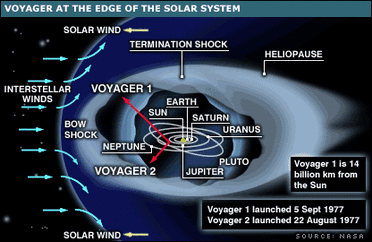
The selection of the music, the images; the construction of the 'gold disk' and the audacity to reach farther than had ever been tried before.
What, you say, am I talking about? Voyager 1 - the original deep space probe, launched back in 1977. Unfortunately, I find now most people only know about V-ger from Star Trek - The Motion Picture (which was like 11 Star Treks ago, and so, thus, diminishing).
The 70s was the era of Cosmos, of Carl Sagan and of unbridled optimism and hope for an ongoing space program. In the same years that Sagan and scientists of his like were warning us of the very real outcomes of thermonuclear war, he was also working with another group of scientists on seeing what was beyond the edge of our perception.

That's where the gold disk comes in; as a teenager, I was fascinated by this, and remember it quite well...
here's some background.
Pioneers 10 and 11, which preceded Voyager, both carried small metal plaques identifying their time and place of origin for the benefit of any other space-farers that might find them in the distant future. With this example before them, NASA placed a more ambitious message aboard Voyager 1 - a kind of time capsule, intended to communicate a story of our world to extraterrestrials. The Voyager message is carried by a phonograph record - a 12-inch gold-plated copper disk containing sounds and images selected to portray the diversity of life and culture on Earth.
The contents of the record were selected for NASA by a committee chaired by Carl Sagan of Cornell University. Dr. Sagan and his associates assembled 115 images and a variety of natural sounds, such as those made by surf, wind and thunder, birds, whales, and other animals.
To this they added musical selections from different cultures and eras, and spoken greetings from Earth-people in fifty-five languages, and printed messages from President Carter and U.N. Secretary General Waldheim. The record is encased in a protective aluminum jacket, together with a cartridge and a needle. Instructions, in symbolic language, explain the origin of the spacecraft and indicate how the record is to be played.
The 115 images are encoded in analog form. The remainder of the record is in audio, designed to be played at 16-2/3 revolutions per minute. It contains the spoken greetings, beginning with Akkadian, which was spoken in Sumer about six thousand years ago, and ending with Wu, a modern Chinese dialect. Following the section on the sounds of Earth, there is an eclectic 90-minute selection of music, including both Eastern and Western classics and a variety of ethnic music.

As Carl Sagan has noted, "The spacecraft will be encountered and the record played only if there are advanced space-faring civilizations in interstellar space. But the launching of this bottle into the cosmic ocean says something very hopeful about life on this planet."
In three studies published last Thursday in the journal Science, Voyager researchers provided the most detailed view yet of a mysterious region more than 11 billion miles from Earth, where the sun’s ferocious solar winds slow to a whisper and pieces of atoms blasted across the galaxy by ancient supernovae drift into the solar system.
The area, which has been dubbed the “magnetic highway,” is a newly discovered area of the heliosphere, the vast bubble of magnetism that surrounds the planets and is inflated by gusting solar winds. Check out this video, which speaks to her current status...

And, for Voyager 1, I'm happy I've lived long enough to see this optimism take it's next leap... out of our boundary and into the infinite... and, I'm with Carl; you can think of it as folly, or fashion it into an incredible optimism, for the unknown.
To make our reach as friends, who wish to share and to know more - to make contact both physical and on whatever level it may be - intellectual, emotional, universal. Quite different than the last 30 years of cinema and television and how they've dealt with the unknown, the 'out-there'.
I still miss Carl Sagan. If you've never watched the PBS series, Cosmos, I can so heartily recommend it for it's science, and it's humanity, and of course, it's stellar developer and narrator!
Give thanks and praise - activate your Wanderlust and take the best of your world as a representation of your humanity!



